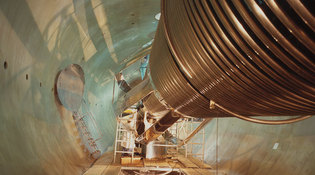 loading
loading
Light & VerityAtom smasher yields to new era in physicsRethinking Wright Lab for the neutrino age.  Jake WymanYale's nuclear accelerator at the Wright Laboratory is being dismantled. View full imageScientists from around the world used to come to the particle accelerator at the former A. W. Wright Nuclear Structure Laboratory on Science Hill to observe the inner working of the atomic nucleus. But the old atom smasher has been supplanted by more powerful models at other facilities, and the lab is now being turned into an empty steel shell in advance of a multiyear renovation. The lab has actually housed two groundbreaking accelerators, one built in the 1960s and its more powerful mid-1980s replacement. “If you worked in nuclear physics,” says Karsten Heeger, director of the Wright Laboratory, “you at some point came through the lab. In that sense, it was a unique facility that had a lot of influence on the field.” But now, new inquiries into dark matter and neutrinos have emerged. Heeger says, “The question was, ‘What is matter made of, and what’s the structure of atoms and nuclei?’ Nowadays, we’re asking, ‘What is all the invisible matter in the universe?’” Professor Reina Maruyama is one of the Yale faculty on the hunt. “There’s five times the dark matter as there is ordinary matter” in all the stars put together, she says. “And we really have no idea what that is right now.” To understand something so mysterious, Maruyama starts with something slightly less so—neutrinos, the subatomic particles passing by the billions every second through every inch of everything on Earth. “The history of the universe is imprinted in dark matter and neutrinos,” she says. “By understanding better how they react with one another and with other matter, we will have a better understanding of how we got here.” But observing neutrinos and dark matter requires shielding from cosmic radiation and other interference. Most facilities are in deep underground labs; two of Maruyama’s experiments are being done under ice at the South Pole. The Wright Lab’s role will be to serve as a center for development of experiments to be completed elsewhere—similar to a lab where astronomers might design and test a new camera or lens before taking it to an observatory to gather data. “With the transformation, we have the opportunity to build one of the leading centers in this kind of research,” says Heeger. “We have a building and space to initiate the development of next-generation experiments. It’s unusual for a university environment.” In the meantime, the public will have a rare opportunity to look inside the old particle accelerator. After the gases used to insulate the outer shell are removed, it will be safe to walk around inside, and Heeger is planning on open houses and public tours. “From the outside, you don’t see much,” he says. “But I would like to make this a place where people learn what we are doing, what has been done here, what we will be doing.”
|
|
1 comment
-

Karen Gorss Benko, 9:45am June 13 2014 |  Flag as inappropriate
Flag as inappropriate
The comment period has expired.I can't believe there are no comments about that last paragraph. A tour of a particle accelerator? When? How do I sign up?